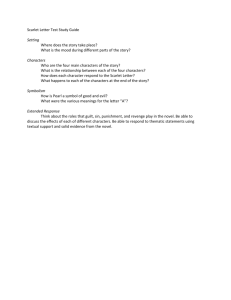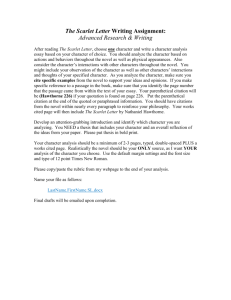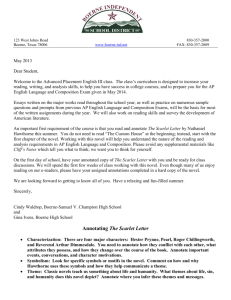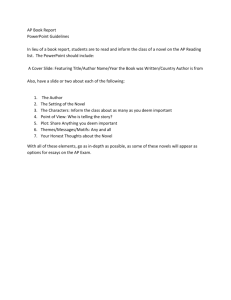File
advertisement
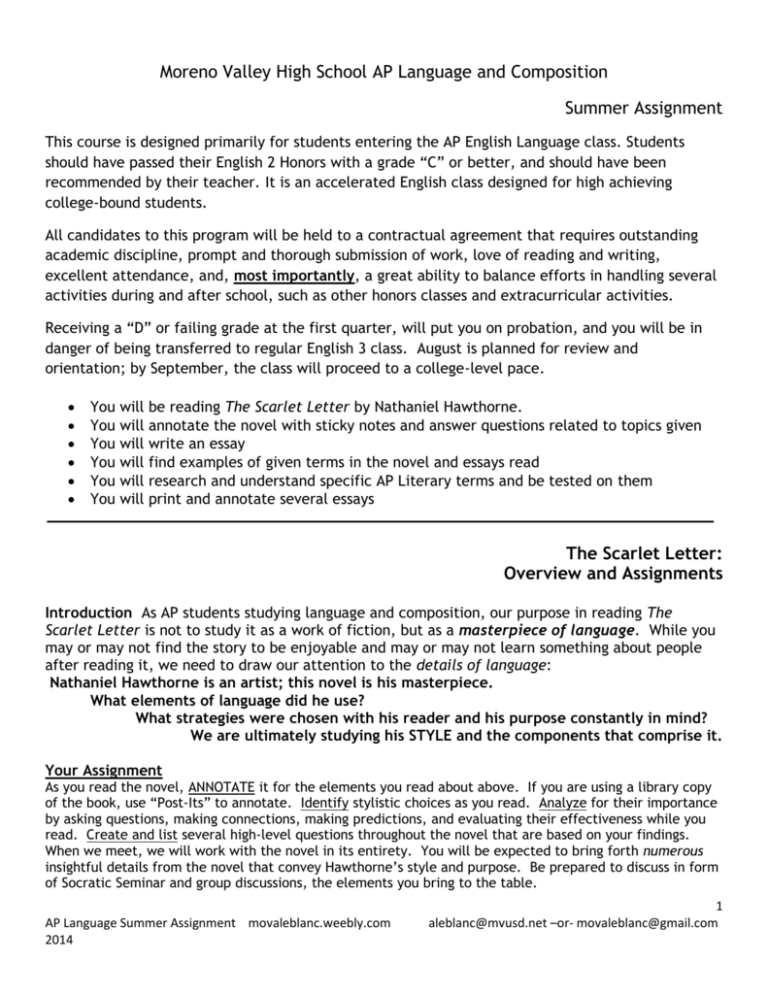
Moreno Valley High School AP Language and Composition Summer Assignment This course is designed primarily for students entering the AP English Language class. Students should have passed their English 2 Honors with a grade “C” or better, and should have been recommended by their teacher. It is an accelerated English class designed for high achieving college-bound students. All candidates to this program will be held to a contractual agreement that requires outstanding academic discipline, prompt and thorough submission of work, love of reading and writing, excellent attendance, and, most importantly, a great ability to balance efforts in handling several activities during and after school, such as other honors classes and extracurricular activities. Receiving a “D” or failing grade at the first quarter, will put you on probation, and you will be in danger of being transferred to regular English 3 class. August is planned for review and orientation; by September, the class will proceed to a college-level pace. You You You You You You will be reading The Scarlet Letter by Nathaniel Hawthorne. will annotate the novel with sticky notes and answer questions related to topics given will write an essay will find examples of given terms in the novel and essays read will research and understand specific AP Literary terms and be tested on them will print and annotate several essays The Scarlet Letter: Overview and Assignments Introduction As AP students studying language and composition, our purpose in reading The Scarlet Letter is not to study it as a work of fiction, but as a masterpiece of language. While you may or may not find the story to be enjoyable and may or may not learn something about people after reading it, we need to draw our attention to the details of language: Nathaniel Hawthorne is an artist; this novel is his masterpiece. What elements of language did he use? What strategies were chosen with his reader and his purpose constantly in mind? We are ultimately studying his STYLE and the components that comprise it. Your Assignment As you read the novel, ANNOTATE it for the elements you read about above. If you are using a library copy of the book, use “Post-Its” to annotate. Identify stylistic choices as you read. Analyze for their importance by asking questions, making connections, making predictions, and evaluating their effectiveness while you read. Create and list several high-level questions throughout the novel that are based on your findings. When we meet, we will work with the novel in its entirety. You will be expected to bring forth numerous insightful details from the novel that convey Hawthorne’s style and purpose. Be prepared to discuss in form of Socratic Seminar and group discussions, the elements you bring to the table. AP Language Summer Assignment movaleblanc.weebly.com 2014 1 aleblanc@mvusd.net –or- movaleblanc@gmail.com Part 1: Literary Devices Style involves the author’s choice and arrangement of words in sentences (diction and syntax), the use of sensory and/or figurative language, the tone, and the mood. Look for such things as the length and complexity of the sentences; the use of words that are obscure, and occasionally, archaic; his allusions (Old Manse, the War of 1812 in “The Custom House”, etc.); the balanced, often parallel syntax; the occasional metaphors; the excessive—by modern standards—punctuation; and the tone of friendly formality. Assignment to be turned in: You will make your own chart on a separate piece of paper similar to the one below. It must be typed or in blue or black ink. As you read, think of adjectives that describe Hawthorne’s style. Think “outside the bubble”, too: How was this style created, and what is its effect on the reader? In a chart form, analyze the style used in the novel. Give a few examples of each throughout the novel. Style Definition Of term Example from text With page number What purpose does Hawthorne have in using this device: What effect does it create for the story? Diction Syntax Figurative Language Sensory Detail Imagery Metaphor Lenth and complexity of sentences Tone Mood AP Language Summer Assignment movaleblanc.weebly.com 2014 2 aleblanc@mvusd.net –or- movaleblanc@gmail.com Part 2: Historical Background and Author Connection “The Custom House” The first “chapter” of the novel is called “The Custom House”, which is entirely a different style than the actual novel that follows. In “The Custom House”, you will become acquainted with the important events of Hawthorne’s life, as well as some of the conventions that early novel writers used, and with Hawthorne’s prose style. Some questions you should be able to answer after reading this section are: You will answer the following questions using mla format, textual evidence, proper citations and formal voice. 1. What is romanticism? 2. What is the purpose of this chapter? 3. How does Hawthorne’s family history contribute to his attitude toward The Custom House and his place in society? AP-Type Questions: 4. How would you describe Hawthorne’s attitude toward his former job and fellow workers? Why do you think so? (This is asking for TONE and evidence supporting your inference.) 5. In this essay, Hawthorne addresses the reader directly. What effect does he create with this manner? 6. What effect does the detailed description of the scarlet letter have on the reader? AP Language Summer Assignment movaleblanc.weebly.com 2014 3 aleblanc@mvusd.net –or- movaleblanc@gmail.com Part 3: Theme The Scarlet Letter explores the effects of sin, guilt, punishment, and revenge. You will make your own chart on a separate piece of paper similar to the one below. It must be typed or in blue or black ink. In a chart, similar to Part 1, give examples from the text with page numbers that relate to the given themes that run throughout the novel: Theme Example from text with page # Example from text with page # Reader’s response: 1-3 sentences Guilt can destroy a person, body and soul. The punishment imposed on us by others may not be as destructive as the guilt we experience. True repentance must come from within. Revenge destroys the victim and the seeker. Even well-intended deceptions and secrets can lead to destruction. One must have the courage to be true to one’s self. It is by recognizing and dealing with their weaknesses that people grow stronger. The choices people make determine what they become. Within each person is the capacity for both good and evil. AP Language Summer Assignment movaleblanc.weebly.com 2014 4 aleblanc@mvusd.net –or- movaleblanc@gmail.com Part 4: Symbolism The Scarlet Letter is considered to be the world’s first truly symbolic novel. You will make your own chart on a separate piece of paper similar to the one below. It must be typed or in blue or black ink. Below are some examples of symbols to watch for that carry through and change throughout the novel, though I’ll leave their interpretations up to you: Symbol Text where Symbol is found (#) Text where Symbol is found (#) Interpretation Text where Symbol is found (#) Interpretation The scarlet letter itself/ the letter A The names of Pearl, Dimmesdale, Chillingworth The forest The scaffold The prison Sunlight The absence and presence of light Colors and absence of color The rose AP Language Summer Assignment movaleblanc.weebly.com 2014 5 aleblanc@mvusd.net –or- movaleblanc@gmail.com Part 5: Rhetorical Devices to achieve purpose Watch for the following as you read. When you find prominent examples of each, actively consider why he used it and how he used it. What is his purpose, and how does using rhetorical devices help him convey his purpose to the reader? Rhetorical Device Contrasts Duality Definition Example Purpose Good/evil, dark/light, forest/town, color/absence of color, supernatural/ reality, etc How does Pearl’s character reflect the duality of the Puritan community?) Allegory Connotations (especially with names); aka characternym (a name that symbolizes or stands for some aspect of the character’s personality) Motif (hand over heart, The Black Man, the color red) Contradiction/ Irony AP Language Summer Assignment movaleblanc.weebly.com 2014 6 aleblanc@mvusd.net –or- movaleblanc@gmail.com Writing Segment: Argumentative Essay Outline: • There are three statements about literature. Defend or refute (go against) one of the following statements; support your stance using specific citations from the two works you have chosen to read. • Your response should reflect your thoughts, observations, and analysis of The Scarlet Letter and one other novel you have recently read. You should include specific textual evidence and citations to help prove your point. For this project, research is discouraged. Your response should be original. • Do not summarize; critically analyze the novels. • 3-4 pages, not including the Works Cited page. • Times New Roman font • Double spaced • Use MLA format for in-text citations and Works Cited page. Annotated Works Cited * For help with MLA citations, go to : https://owl.english.purdue.edu/owl/resource/747/01/ • Due Date: The first Friday of school. ~Make sure it is printed AND e-mailed to your assigned teacher upon your arrival. Statement One: "A story must be exceptional enough to justify its telling; it must have something more unusual to relate than the ordinary experience of every average man and woman" --- Thomas Hardy Statement Two: "What lasts is what is written. We look to literature to find the essence of an age" --- Peter Brodie Statement Three: "Thus all art is propaganda and ever must be, despite the wailing of the purists ... I do not care a damn for any art that is not used for propaganda"--- W.E.B. DuBois AP Language Summer Assignment movaleblanc.weebly.com 2014 7 aleblanc@mvusd.net –or- movaleblanc@gmail.com AP Summer Vocabulary: *make use of the dictionary and google to fully understand the meaning as well as function of the word in literature. Your vocabulary assignment must be TYPED in MLA format. Here are 20 vocabulary words. Be sure to study these words and gain a good understanding of them. For each word you must relate them to your novel. You must then: 1. Write an explanation of how the word relates to your novel of choice. (2-3 sentences) 2. Find a citation from the novel that relates to the vocabulary word. Please remember to use proper MLA citation format. Example Vocabulary Exercise Capricious: Scout, in the novel To Kill a Mockingbird, is very capricious in her everyday actions. She continuously surprises her brother Jem and her friend Dill with her ability to keep up with the boys not matter what they do. She also often has outbursts that display her powerful personality. A citation that exemplifies how Scout is capricious is when she impulsively fights her cousin. Scout states, "This time, I split my knuckle to the bone on his front teeth. My Left impaired I sailed in with my right, but not for long" (Lee 84). Rhetoric: Rhetoric is the art of using language as a means to persuade. Along with grammar and logic or dialect, rhetoric is one of the three ancient arts of discourse. From ancient Greece to the late 19th Century, it was a central part of Western education, filling the need to train public speakers and writers to move audiences to action with arguments. The very act of defining has itself been a central part of rhetoric, appearing among Aristotle's Topics. **Rhetor: in ancient Greece and Rome, a master or teacher of rhetoric; an orator. Bombastic: Using or characterized by high-sounding but unimportant or meaningless language; pompous; grandiloquent Ethos: An appeal based on the character of the speaker. An ethos-driven document relies on the reputation of the author. Logos: An appeal based on logic or reason. Documents distributed by companies or corporations are logos-driven. Scholarly documents are also often logos-driven. Pathos: An appeal based on emotion. Advertisements tend to be pathos-driven. Capricious: Impulsive; unpredictable Tone: The writer's attitude, mood or moral outlook toward the subject and/or readers, i.e. as angry, empathetic, critical, ironic, suspicious, comic, surprised, sarcastic or supportive, etc. Appeal: The power of arousing a sympathetic response, to arouse a sympathetic response. Argument: Discourse intended to persuade; the subject matter, a process of reasoning. Colloquialism (colloquial): A word or phrase used in an easy, informal style of writing or speaking. It is usually more appropriate in speech than formal writing. Colloquialisms appear often in literature since they provide a sense of actual conversation and use the pronunciation, grammar, and vocabulary of everyday speech. Mark Twain makes use of colloquialisms in his Huckleberry Finn, such as in the opening line of the story, "You don't know about me without you have read a book by the name of The Adventures of Tom Sawyer, but that ain't no matter" (Twain 1). Connotation: Suggestions and associations which surround a word as opposed to its bare, literal meaning. It is the opposite of denotation. Literature uses connotation; science and philosophy use denotation. Connotation refers to qualities, attributes, and characteristics implied or suggested by a word and depend upon the context in which the word is used. Apathy: A lack of feeling or emotion, lack of interest or concern. Paradox: A statement that appears to be contradictory, but which reveals a deeper truth. For example, one of the most important principles of good writing is this: "Less is more." It means that the most effective writing is clear and focused; everything extraneous is avoided. As Chesterton used the term, a paradox can refer both to a true statement, which at first seems to be false; and to a false statement, which at first seems to be true. Dialect: Variety of language confined to a region or group, manner or means of expressing oneself Understatement: A statement which says less than is really meant. It is a figure of speech which is the opposite of hyperbole. Hyperboles exaggerate; while understatements minimize. Hyperbole: Deliberate and obvious exaggeration for effect. Example: "I have tons of money." Anecdote: A short narrative of an interesting, amusing or biographical incident. Condescending: Patronizing or assuming superiority. Voice: An author's distinctive literary style, basic vision and general attitude toward the world. This "voice" is revealed through an author's use of SYNTAX (sentence construction); DICTION (distinctive vocabulary); PUNCTUATION; CHARACTERIZATION and DIALOGUE. The voice of an author may cover a wide range of possibilities (i.e. "victim," "judge," "friend," "coach," "spy," "opponent," "cheerleader"). AP Language Summer Assignment movaleblanc.weebly.com 2014 8 aleblanc@mvusd.net –or- movaleblanc@gmail.com Rhetoric Readings Please print the essays below and bring them to class on the first day. The links are available on the following webpage. They can be found through Google or the links under them. Read each essay and annotate based on your overall understanding of the texts. Annotation is the process of writing reflective comments regarding opinions, connections, and questions. You may want to highlight important names and information. Instructions for annotating can be found at http://www.bucks.edu/~specpop/annotate.htm. You must come to class on the first day prepared to discuss all of the essays. A writing assignment may follow the class discussion. "Why I Want a Wife" by Judy Brady o http://www.columbia.edu/~sss31/rainbow/wife.html "Politics and the English Language" by George Orwell o http://www.orwell.ru/library/essays/politics/english/e_polit/ Due first Friday of School. Do not procrastinate. Checklist of Work: Highlight each assignment after it is completed Reading Annotate Novel Chart 1: Style Author Background: The Custom House Chart 3: Theme Chart 4: Symbolism Chart 5: Rhetoric Essay Choose second novel Choose a prompt Begin an outline Vocabulary Rhetoric Print Essays Printed and formatted vocabulary assignment. Annotate Essays Rough Draft Final Draft *You may reach me any time through email, twitter, or facebook. FB: movaleblanc leblanc Twitter/gmail: movaleblanc AP Language Summer Assignment movaleblanc.weebly.com 2014 9 aleblanc@mvusd.net –or- movaleblanc@gmail.com
